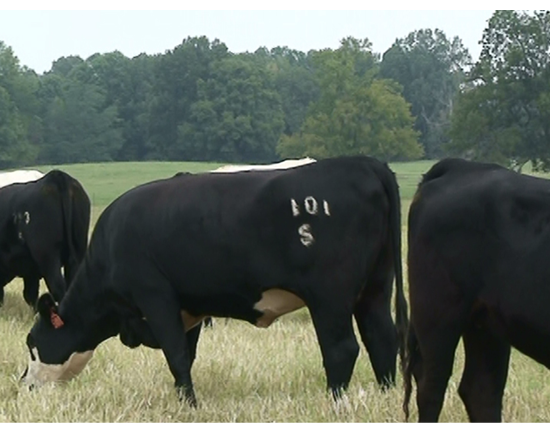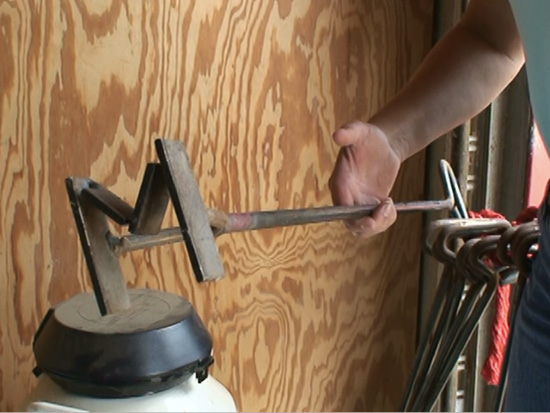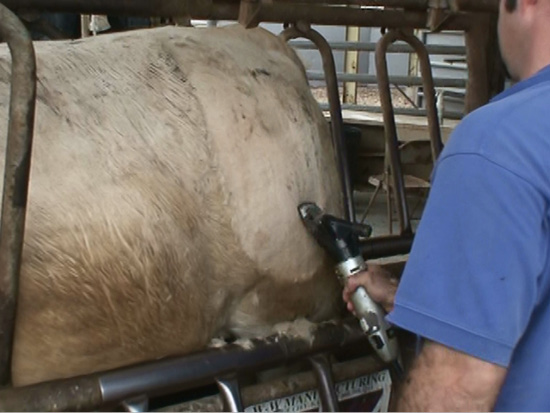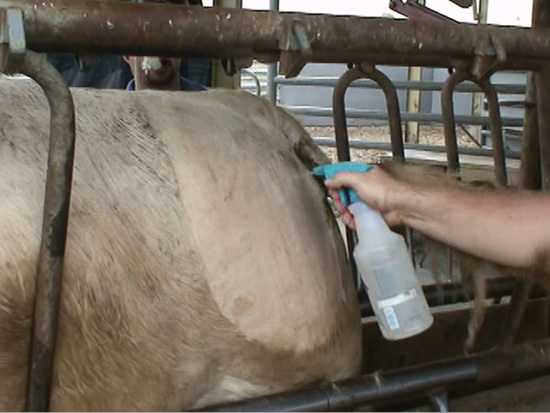Freeze Branding Beef Cattle
Animal Identification
Individual animal identification is an integral part of good herd record keeping and management. Selection decisions, pairing up cows and calves, treating injured or ill cattle, and estrus detection are just a few of the many routine management practices where individual animal identification is important. The 2007 National Animal Health Monitoring System BEEF 2007–08 study found that about half (53.3 percent) of the beef cattle operations surveyed across the United States used no individual calf identification and about one-third (34.9 percent) used no individual cow identification.
Plastic ear tags are the most common form of individual animal identification. In 2007, 57.5 percent of U.S. beef cows were identified using plastic ear tags, 20.5 percent with hot iron brands, 9.8 percent with ear notches, 7.7 percent with ear tattoos, 3.9 percent with freeze brands, and 1.2 percent with electronic ID. The breakdown of calf identification methods was similar, with 50.2 percent plastic ear tagged, 12.3 percent Bang’s tagged, 11.8 percent hot iron branded, 11.2 percent ear notched, 5.6 percent ear tattooed, 2.9 percent electronically identified, 2.0 percent metal ear tagged, and 1.1 percent freeze branded.
One of the oldest forms of individual animal identification is branding. Branding is a form of permanent identification that also helps protect against livestock theft. Brands can identify herds, where each animal has the same herd identifier. They can also identify individual animals, where each animal has a unique identifier.

Freeze Branding Methods
Freeze branding can be a relatively painless and very effective form of permanent animal and herd identification. Research indicates that freeze branding is more comfortable to cattle than is hot iron branding. While hot iron branding makes a neat, legible scar on the surface of the hide, freeze branding changes hair color to white. Freeze branding works by destroying the pigment-producing cells in hair follicles, resulting in white hair growth. Freeze brands typically become readable about 6 to 8 weeks after branding. Spring or autumn is a recommended time to freeze brand, as a new hair coat is starting. Freeze branding can be successful during any time of the year, but brands applied after a new hair coat is already on an animal may take up to 4 months to appear as white hair.
Liquid nitrogen or a combination of denatured alcohol and dry ice are effective methods for cooling freeze branding irons. Denatured alcohol is undrinkable and is used for industrial purposes. Mississippi State University’s South Farm currently uses the alcohol and dry ice method because it reduces the risk of scarring hides. One downside to using alcohol and dry ice is that the iron must be placed on the hide for a longer period than with the liquid nitrogen method. Liquid nitrogen (-344°F) cools freeze branding irons to a colder temperature than do alcohol and dry ice (-112°F).
When using liquid nitrogen to cool branding irons, press the iron against the hide for about 20 to 45 seconds, depending on the age of the animal and outside temperature. Irons may need to be held to the hide for a longer time in hot weather or on the thick hides of Brahman-influenced cattle. When using denatured alcohol and dry ice to cool branding irons, press the iron against the hide for approximately 45 to 60 seconds. White cattle can be freeze branded to make a bald or bare brand. When using the dry ice and alcohol method on light-colored cattle, hold the branding irons against the hide for about 75 to 90 seconds to make a bald brand. Freeze branding takes more time than hot branding, so fewer head of cattle can be branded in a given period.
|
Branding Method |
Dark Coat |
Light Coat (Bald Brand) |
|---|---|---|
|
Dry Ice / Alcohol |
45–50 seconds |
75–90 seconds |
|
Liquid Nitrogen |
20–45 seconds |
45–50 seconds |
Supplies Needed for Freeze Branding with Dry Ice and Alcohol
- Cattle working facility with an area to restrain individual animals (squeeze chute)
- Freeze branding irons
- Ice chest (plastic or Styrofoam, not metal)
- Dry ice
- Denatured alcohol
- Clippers and a source of electricity
- Spray bottle
- Rag or brush to clean the clipped area
- Timer or clock with a second hand or digital second display
- Leather gloves
Irons suitable for freeze branding are often made of copper alloy. Copper irons tend to work better than stainless steel and aluminum irons because they transfer cold well. Freeze branding irons are recognizably different from hot branding irons. They do not have breaks in the metal at key joints to release excess heat, they typically have shorter handles, and they usually have a thicker branding surface area.

Some stainless steel irons are marketed for use in both freeze and hot iron branding, but using dual-purpose irons for freeze branding may give less desirable results than using copper or other irons designed specifically for freeze branding.

Many different sizes of irons are available. Consider what size brand is needed to be legible at a distance. Also, consider the brand location and age of the animal. At the South Farm, yearlings are branded directly below the hip with 3-inch irons. Four-inch irons were used in the past, but smaller irons improve the appearance of brands and reduce the amount of hide damage. Some Mississippi beef cattle operations brand on the shoulder with irons as small as 1.5 inches tall.
When using dry ice and alcohol, make a mixture that allows the irons to be submerged but is not watery. A 50:50 mixture often works well. One gallon of alcohol and 20 pounds of dry ice will brand about 20 head of cattle in most situations.
When working a full day, 50 to 75 pounds of dry ice will be needed. Use a minimum of 95 percent pure denatured isopropyl, methyl, or ethyl alcohol to prevent freezing and slush build-up. Ninety-nine percent pure denatured alcohol works best. When the humidity is high, the solution eventually will become diluted with moisture from the atmosphere. On humid days, drain used alcohol and replace it with fresh alcohol after several hours.
Place irons in an ice chest with enough dry ice and alcohol to submerge the branding surface completely, at least 2 inches up the handle. About 2 inches of crushed dry ice covering the bottom of the cooler will be needed. The alcohol/dry ice mixture will slowly evaporate, so add alcohol and dry ice throughout the working session to keep the iron surfaces submerged. Irons are ready to use when the refrigerant mixture stops boiling and frost builds up around the base of the irons. Waiting 15 to 20 minutes from the time the irons are placed in the cooler until first use is a good rule of thumb. Usually, the more irons cooled at once, the longer it takes to cool them. When irons are reused, cool them at least 1 to 2 minutes between applications.

Before applying branding irons to the hide surface, make sure that the animal is properly restrained (preferably in a squeeze chute). Clip, clean, and spray the branding area with a layer of denatured alcohol.
Clipping serves two purposes. It prepares the hide to receive the brand by removing the layers of insulating hair, and it provides a visual guide for brand placement. The shorter the hair is clipped, the less iron application time is needed to achieve a good brand. Clipping in a block pattern, with level and square edges, makes proper brand placement much easier and results in a more attractive brand.

Use a cloth rag or brush to remove clipped hair, manure, and other debris that may interfere with iron-to-hide contact. The denatured alcohol sprayed onto the hide forms a layer that helps transfer the cold temperature of the iron to the hide. Apply enough denatured alcohol to wet the hide thoroughly.


Always check the iron and animal information before branding to make sure the correct iron is applied. Begin timing when the iron first contacts the hide. Press the iron face to the hide hard enough to make sure that there is good contact over the entire surface of the iron. The animal may react within the first 10 seconds of brand contact.
The extreme cold usually freezes the nerve endings after 10 seconds, and the animal will then stop moving in response to the iron in most cases. As the animal shifts position, keep the brand applicator in the same location. Apply significant force behind the iron by leaning into it. This ensures good contact and keeps the iron from sliding around. If the iron loses contact with the branding location on the hide, reapply the iron to the same location. An outline of the brand number, letter, or symbol should be visible and can be used to indicate where to reapply the iron.
Keep up with the amount of time the iron contacts the hide to get the full 45- to 60-second application. A watch or timer displaying seconds is an important piece of equipment to have on site when freeze branding.

Step by Step Instructions
- Let the irons cool for 20 minutes before first use.
- Properly restrain the animal.
- Clip the area to be branded.
- Brush or wipe the area clean.
- Spray a liberal coat of alcohol on the clipped surface.
- Apply the branding iron for the predetermined amount of time. If the iron moves, reapply it to the depressed area and add a few seconds to the application period.
- If an iron needs to be used twice (e.g., 77 or MM), let it re-cool for at least 2 minutes between applications.
Quality Challenges
When branding cattle, consider Beef Quality Assurance. Hides are an important by-product of beef production. The 2000 National Beef Quality Audit (NBQA) cited hide damage from brands as one of the top 10 quality challenges facing the beef industry. The 2005 NBQA revealed that 62 percent of the fed cattle assessed were not hot iron branded, up from the 49.3 percent value reported in the 2000 NBQA.
Brand size and location affect the value of the hide. Of the cattle evaluated as part of the 2005 NBQA, 3.7 percent had multiple brands, 0 percent had shoulder brands, 7.5 percent had side brands, and 26.8 percent had butt or hip brands. Side brand sizes ranged from 1 to 900 square inches in the 2000 NBQA. One of the industry goals set by the 2000 NBQA was to eliminate side-branded hides. Fewer side brands and hot iron brands were noted in the 2005 NBQA than in any previous audit.
Cattle should be in good flesh or condition when branding. Thin cattle can be more difficult to brand effectively, and the result may not be satisfactory. Avoid excessive hide damage and poor placement of brands by branding responsibly.
Responsible branding includes reducing the size of the branding area through choosing the smallest-sized branding iron that will meet ranch needs, choosing a branding location that minimizes hide value losses, and applying irons properly. Freeze branding can be a good alternative to hot iron branding for reducing hide damage.
There is great potential for increased use of freeze branding in Mississippi. This relatively simple procedure only takes a little preparation and patience during the process. Contact your local MSU Extension office for more information on cattle identification or related topics.
References
Lay, D. C., Jr., Friend, T. H., Randel, R. D., Bowers, C. L., Grissom, K. K., & Jenkins, O. C. (1992). Behavioral and physiological effects of freeze or hot-iron branding on crossbred cattle. Journal of Animal Science, 70(2), 330–336.
National Cattlemen’s Beef Association. (2000). National Beef Quality Audit—2000. Centennial, CO.
National Cattlemen’s Beef Association. (2005). National Beef Quality Audit—2005. Centennial, CO.
Schwartzkopf-Genswein, K. S., Stookey, J. M., & Welford, R. (1997). Behavior of cattle during hot-iron and freeze branding and the effects on subsequent handling ease. Journal of Animal Science, 75(8), 2064–2072.
Schwartzkopf-Genswein, K. S., Crowe, T. G., & Genswein, B. M. (1998). Comparison of image analysis, exertion force, and behavior measurements for use in the assessment of beef cattle responses to hot iron and freeze branding. Journal of Animal Science, 76(4), 972–979.
U.S. Department of Agriculture. (2009). National Animal Health Monitoring System BEEF 2007–08. Washington, D.C.
Publication 2464 (POD-02-25)
Reviewed by Brandi Karisch, PhD, Associate Extension/Research Professor, Animal and Dairy Sciences. Written by Jane A. Parish, PhD, Professor and Head, North Mississippi Research and Extension Center, and Justin Rhinehart, PhD, former Assistant Extension Professor.
The Mississippi State University Extension Service is working to ensure all web content is accessible to all users. If you need assistance accessing any of our content, please email the webteam or call 662-325-2262.





